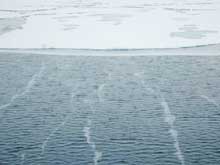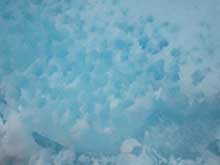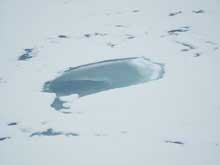
The fresh fallen snow accumulates in bands on the open water, while the blue and grey melt ponds and puddles cover parts of the ice floe in the background. Click image for larger view.
When the Ice Melts…
July 10, 2005
Rolf Gradinger
Chief Scientist
University of Alaska's School of Fisheries & Ocean Sciences
The oceans close to the poles are unique environments. Plants and animals
living in Arctic and Antarctic Seas have evolved to endure months of darkness
followed by months of permanent light. Even more unique is the existence
of sea ice. In the Arctic, ice forms during the cold winter months from
October to March. During our Arctic exploration expedition, we experience
the opposite, the Arctic sea ice melt. All along our cruise track, the
ice floes are covered with melt puddles, and the freshwater created by
the ice melt can lower the salt content of the surface water of the ocean.
The melt puddles are mostly blue and grey and I sometimes drink the water
when I am thirsty on the ice - it is fresh and cold. Although the ponds
and puddles are shallow (<1m) and exist only for a few weeks, we find
freshwater algae within these lakes. We assume that the algae survive the
cold winters in a resting stage and some might be blown from land by wind
into the puddles each summer. Ice melt dominates the Arctic and continues
until the end of September. In some regions of the Arctic all ice disappears,
while other areas (mainly the deep central basins) have a sea ice cover
year-round. Over the last 30 years, the summer ice melt has increased and
less multi-year sea ice is found in the Arctic. Biologists are concerned
about the impact of such changes on the Arctic marine life, and several
species might become extinct because of the loss of summer sea ice, not
only polar bears but also many small species adapted to life with multi-year
sea ice.

Ice floes turned around by the moving icebreaker frequently show a rotten appearance due to the melting processes occurring in all levels of the ice sheets. Click image for larger view.
Sign up for the Ocean Explorer E-mail Update List.

































